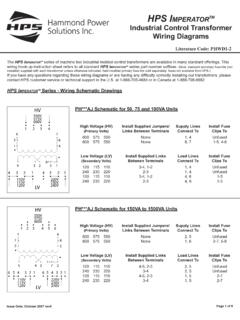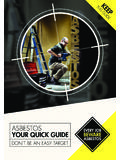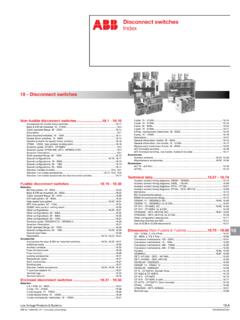Transcription of Industrial Control Wiring Guide - Weebly
1 Industrial ControlWiring GuideIndustrial ControlWiring GuideSecond editionBob MercerOXFORD AUCKLAND BOSTON JOHANNESBURG MELBOURNE NEW DELHIN ewnesAn imprint of Butterworth-HeinemannLinacre House, Jordan Hill, Oxford OX2 8DP225 Wildwood Avenue, Woburn, MA 01801-2041A division of Reed Educational and Professional Publishing member of the Reed Elsevier plc groupFirst published 1995 Reprinted 1996, 1998, 1999 Second edition 2001 R. B. Mercer 1995, 2001 All rights reserved. No part of this publication may be reproduced inany material form (including photocopying or storing in any medium byelectronic means and whether or not transiently or incidentally to someother use of this publication) without the written permission of thecopyright holder except in accordance with the provisions of the Copyright,Designs and Patents Act 1988 or under the terms of a licence issued by theCopyright Licensing Agency Ltd, 90 Tottenham Court Road, London,England W1P 0LP.
2 Applications for the copyright holder s writtenpermission to reproduce any part of this publication should be addressedto the publishersBritish Library Cataloguing in Publication DataA catalogue record for this book is available from the British LibraryISBN 0 7506 3140 6 Composition by Genesis Typesetting, Laser Quay, Rochester, KentPrinted and bound in Great Britain1 Personal Building safe Types of Wire types and Insulation Wire Standard Wire Coaxial and screened Multiway Insulation Soldering and Soldering Forming the Soldering the Crimped Screw clamp Terminating coaxial Cable Continuous Spot Laying the Twisted Cable Connections and Conductor and cable Conductors of different Component mounting Plastic Connector Screw Components (active) Contactors and Components (passive) Switches and Earthing and Earthing the protective Screen System earth PLC Power supply Wiring of inputs and Personal safetyConcern for your own safety as well as the safety of others should always be on your mind.
3 Most safetyprocedures are common sense but, because some hazards are not obvious, there are regulations born outof experience which are designed to make the workplace are two aspects of safety which concern us in the assembly of electrical equipment and first concerns your own personal safety. In the words of the Health and Safety Regulations: the need to use safe working practices and safety equipment to avoid the risk of injury to yourselfand to others in the course of your it is beyond the scope of this book to cover the detail of all the safety precautions and safe workingpractices which should be adopted, there are some general points which can be noted. Safety equipment, goggles, gloves, etc., should be provided and must be usedwhere they areappropriate. The onus is on you to use the safety equipment provided by your company. Any damage to safetygear should be reported.
4 Safe working practices are part of any job and you should always learn andadopt them as a natural way of working. Don t take shortcuts which compromise your safety, or that of anybody else. You should make yourself aware of the procedures used at your place of work to prevent accidentsand to deal with common incidents. You should know how to isolate electric supplies and how to work safely on electrical Accidents Know how to contact the correct person thedesignated first aider for help. Find out the location of the nearest first aidbox. Know how to isolate electric supplies and howto release a person safely from contact FireBefore commencing work on electric plant, youshould know: Where is the nearest fire alarm activator, fire exitand fire extinguisher? Are the fire exits clear of equipment orrubbish? Extinguishers for electrical firesBe aware that special extinguishersare needed forfires which occur in live electrical equipment do notuse water-based extinguishers.
5 RED extinguishers are water-based for wood/paper/cloth/plastic fires only. GREEN extinguishers are halon or BCF-basedfor general fires (not gases) including electricalfires. BLACK extinguishers are CO2-based for flam-mable liquids and electrical Electric shockLearn the basic first aid action drill. DO NOT TOUCHthe victim with your barehands until the power is off or they have beenpulled away from contact otherwise you will geta shock as well. Switch off the power and drag the victim off thelive conductor. Alternatively if you cannot switch off then usesomething non-conductingto move the victimaway from contact. Dry wood, plastic tubing(PVC conduit) even a dry piece of cloth foldedseveral times will Working with electrical equipmentMany of the tools we use are electrically powered,some by the mains, some by battery. Mains-driven portable tools should be connectedto the supply through an isolating transformer.
6 These are usually 110 V systems which reducethe effect of electric shock. Heavier, fixed machines are wired into the three-phase factory supply. This is 415 V and there arestringent safety regulations governing its installa-tion and .. Do not take liberties or chances with electricity. Don t interfere with electrical apparatus, use it as intended and don t remove any covers orpanels. Don t use or tamper with electrical machinery and tools that do not concern you. Leave switches andbuttons alone. If you want to know how something works then ask someone who is authorised toshow you. Take care when using portable electric power tools since these cause the highest number of accidentsin the workplace. Accident possibilities range from tripping over a carelessly laid power cord togetting swarf in your eye because you didn t wear eye Building safe equipmentThe second aspect of safety concerns the requirementto: design, construct and use electrical equipment sothat it is safe and does not give rise to dangereven should a fault designer of the equipment will have taken intoaccount all these concerns in specifying the parts to beused, the wire types and colours, the type of enclosureand so on.
7 Our part comes in ensuring that: no parts are to be substituted without anengineering change notice; manufacturers instructions for any componentmust be of these aspects are statutory requirements laiddown in law in a number of The Health and Safety at Work Act(HSAW)This is a wide-ranging Act of Parliament covering allaspects of safety at work. It has gradually replaced theFactories HSAW allows for the introduction of regulations tocontrol particular aspects of safety at work. Theseregulations, which must be complied with, are oftenproduced because of European Directives, which inturn are designed to harmonise the safe working con-ditions for all members of the European the many regulations within the Act, somehave a direct influence on the machinery controlpanels which we are interested in, for example: The Electricity at Work Regulations 1989. The Provision and Use of Work Equipment.
8 The Supply of Machinery (Safety) Regulations. The Electrical Equipment (Safety) affect other areas of safety besides those whichconcern us here and it is outside the scope of this bookto go into any real detail on them. However, you mayfind it useful to consider how they affect the way webuild these panels and the components we use in StandardsA standard is a document specifying nationally orinternationally agreed properties for manufacturedgoods and and standards are two different things:regulations are the law and must be complied with;standards on the other hand are advisory. They areclosely linked sold in the EEC must be CE marked toshow that it complies with the regulations that areconcerned with its safety. As part of this process themanufacturer must show how the risks and hazardsthat the equipment will present have been overcome orprotected against. This information is placed in theTechnical Document of the equipment so that it can beinspected should there be a query by the authoritiesregarding the equipment s safety or best way to show compliance with a regulation isto use recognised standards in the design and con-struction of the product, thereby fulfilling the require-ments of the British Standards Institute (BSI), as well as otherEuropean and international bodies, publish standardswhich give recommendations and guidance on amongst other things the selection and use of variouselectrical components and are three types of standards that are important tous: British Standards (BS), European Harmonised Standards (EN or BS EN), International Standards (IEC).
9 These are of course mainly the concern of the designerbut it is as well to be aware that they exist, as it mayexplain why one component is used instead of anotherand why only those components designated in theparts list must be of most importance to us are: BS EN 60204 Safety of Machinery ElectricalEquipment of Machines, BS EN 60947 (IEC947) Low Voltage Switch-gear and Controlgear (7 Parts).41. SAFETYBS EN 60204 covers the way in which the electricalequipment should be constructed and includes every-thing from the selection of components, through thesizes, types and colour of the Wiring , to the electricaltests that should be done on the finished BS EN 60204 there are references to otherstandards, including BS EN 60947, that will give moredetail on individual parts or EN 60947 and the international standard IEC 947are in seven parts, giving the specification and otherrequirements of the individual components we willuse in the equipment.
10 Part 1: General Requirements. Defines the rulesof a general nature to obtain uniformity inrequirements and of the following parts deals mainly with thecharacteristics, conditions for operation, methods fortesting and marking requirements of the variouselectrical components. Part 2: Circuit-breakers. Part 3: Switches, disconnectors, switch-discon-nectors and fuse combination units. Part 4: Contactors and motor starters includingshort circuit and overload protection devices. Part 5: Control circuit devices and switchingelements. Part 6: Multiple function equipment such as thatused for automatic emergency power switching. Part 7: Ancillary equipment such as terminalblocks used to connect copper our Control equipment panels should be builtto conform to the requirements of BS EN 60204 usingcomponents manufactured to conform to the require-ments of BS EN 60947 and other related componentstandards and approved component is one whose manufactureand performance has been checked and proven to meetthe specifications set by the standards authority of anindividual country.





